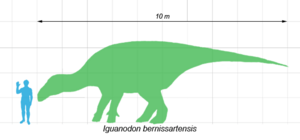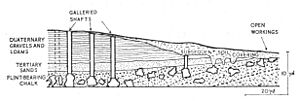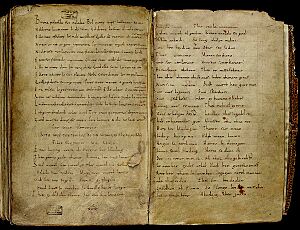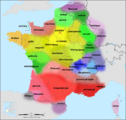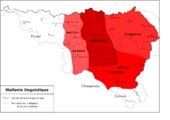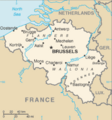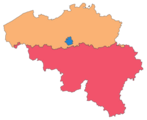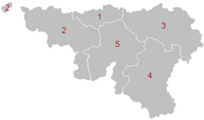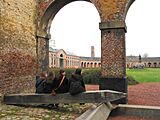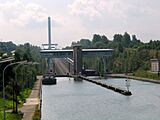History of Wallonia facts for kids
The history of Wallonia tells the story of a region that today is a part of Belgium. Since 1970, Wallonia has been a specific area within Belgium, and it also includes a smaller German-speaking community. The name Wallonia comes from the old Germanic word Walh, which was used to describe people who spoke Celtic or Latin languages. Think of how "Wales" got its name!
Contents
Ancient Times
Prehistoric Discoveries
Imagine finding dinosaur bones deep underground! In 1878, a coal mine in Bernissart, Wallonia, uncovered the largest collection of Iguanodon fossils ever found. These huge dinosaurs lived about 120 to 130 million years ago.
Another amazing discovery was made in 1886 at the Grotte de Spy (Spy Cave). This cave is one of Europe's most important sites for learning about the Paleolithic (Old Stone Age). Scientists found proof that Neanderthals lived there!
Near the city of Mons, you can find the ancient Neolithic (New Stone Age) flint mines of Spiennes. These mines are so special that UNESCO has listed them as a World Heritage Site. They are described as the "largest and earliest concentration of ancient mines in Europe," showing how advanced people were back then.
Roman Influence
After Julius Caesar conquered Gaul (an ancient region that included parts of modern-day France and Belgium), the people living there became known as Gallo-Romans. Their Germanic neighbors called them "Walha," which is where the name Wallonia comes from. These people started speaking a form of Latin instead of their old Celtic languages.
Wallonia was right on the edge between areas where people spoke Germanic languages and where they spoke Latin-based languages. Historians say Wallonia has always been a "Romance land" (meaning it speaks a language from Latin) since the Roman times. It was like a Latin "vanguard" or front line in Germanic Europe.
One important piece of evidence for Wallonia's Latin identity is the Sequence of Saint Eulalia, a very old poem written around 880 AD. Its language shows traits of Walloon, Picard, and Lorrain, which are all regional languages spoken in or near Wallonia.
The Long-Lasting Language Border
The most important event in Wallonia's history, according to some historians, was the Barbarian invasions. These invasions led to a clear language border in Belgium, dividing it into two main parts: a Germanic-speaking north (Flanders) and a Latin-speaking south (Wallonia).
This language border has stayed mostly the same since the 1700s. It became officially important in 1822 when laws were made about using Dutch in Flemish towns.
-
Gaul, conquered by Julius Caesar, became part of the Roman Empire. This led to French-speaking Europe, including France, Wallonia, Brussels, and French-speaking Switzerland.
-
Languages of France. Wallonia is in the northeast, with the Walloon language (dark green), a bit of Picard language (light green), and a bit of Lorrain language (light green).
-
Regional languages of Wallonia: Walloon language (yellow), Picard language (green), and Lorrain language (brown). There are also smaller Germanic areas (blue or white).
-
Political Wallonia compared to other regions in Belgium.
Flemish Region Brussels-Capital Region Walloon Region -
The five provinces of Wallonia: Walloon Brabant (1), Hainaut (2), Liège (3), Luxembourg (4), and Namur (5).
Industrial Powerhouse
Rich Resources
The Ardennes region in Wallonia is an old mountain area. Deep inside these mountains, you can find coal, iron, zinc, and other valuable metals. To the north and west of the Ardennes are the valleys of the Sambre and Meuse rivers. This area, called the Sillon industriel (Industrial Furrow), became the heart of Wallonia's industry. It stretches across provinces like Hainaut, Charleroi, and Liège.
Many important geological periods were named after places in Wallonia, like Frasnian, Famennian, and Namurian. This shows how rich the region is in different types of rocks and minerals.
Before the 1700s, the first iron furnaces in Wallonia used charcoal from the Ardennes forests. But after the 1700s, the steel industry started using coal, building factories near coal mines in cities like Liège and Charleroi. Wallonia quickly became the second most industrial power in the world for its size and population!
The Walloon Process
In the Middle Ages, there was a big demand for iron to make cannons. This led to important new ways of working with iron in Wallonia, especially in the Liège region. This was called the Walloon process. It involved making "pig iron" in a blast furnace and then refining it in a special forge. This method was so good that it spread to France and even to England and Sweden.
The Start of the Industrial Revolution
The Industrial Revolution really took off in Wallonia. New methods like "puddling" and better blast furnaces meant that coal (coke) could replace charcoal in metal production. By 1870, most metalworking used coal.
Early steam engines were used in mines near Liège by 1723 and in Charleroi by 1725. By 1860, these engines were producing a lot of power, showing how quickly Wallonia was adopting new technology.
Wallonia: Second Industrial Power
Wallonia was truly a global leader in industry. Historians and economists agree that Belgium (meaning Wallonia, where most of the industry was) was the second most industrial power in the world, after the United Kingdom. This was based on things like how much cotton, iron, steel, and coal were used, and how many railways were built.
Here's a table showing how Wallonia (listed as Belgium) ranked among industrial powers:
| Rank | 1810 | 1840 | 1860 | 1880 | 1900 | 1910 |
| 1 | United Kingdom | United Kingdom | United Kingdom | United Kingdom | United States | United States |
| 2 | Belgium | Belgium | Belgium | Belgium | United Kingdom | United Kingdom |
| 3 | United States | United States | United States | United States | Belgium | Belgium |
| 4 | France | Switzerland | Switzerland | Switzerland | Switzerland | Germany |
| 5 | Switzerland | France | France | Germany | Germany | Switzerland |
| 6 | Germany | Germany | Germany | France | France | France |
| 7 | Sweden | Sweden | Sweden | Sweden | Sweden | Sweden |
| 8 | Spain | Spain | Spain | Spain | Spain | Spain |
| 9 | Italy | Italy | Italy | Italy | Italy | Italy |
| 10 | Russia | Russia | Russia | Russia | Russia | Russia |
| 11 | Japan | Japan | Japan | Japan | Japan | Japan |
Wallonia's success was due to its advanced technology and good location for exporting goods. It exported steam engines, locomotives, and other metal products to many countries. In 1833, Belgium had five times more steam machines per person than France!
-
Lift no. 3, one of four old hydraulic boat lifts on the Canal du Centre, a World Heritage Site.
Challenges and Changes
Even though Wallonia was very successful, its industries became very dependent on financial groups in Brussels. As Walloon companies grew, they needed more money, and banks in Brussels gained a lot of control over them.
Also, the political power in Belgium started to shift. For a long time, French-speaking leaders from both Wallonia and Flanders held power. But after 1884, the Catholic Party, which was stronger in Flanders, gained control. This made Wallonia feel like its political influence was decreasing.
| Periods and Governments | Flemish Ministers | Ministers from Brussels | Walloon Ministers |
| A. Beernaert : October 26, 1884/ March 17, 1894 | 60% | 14% | 26% |
| J. de Burlet : March 26, 1894/ June 25, 1896 | 75% | 9% | 16% |
| P. de Smet de Naeye : June 26, 1896/ January 23, 1899 | 87% | - | 13% |
| J. Vandenpeereboom : January 24, 1899/ July 31, 1899 | 84% | - | 16% |
| Paul de Smet de Naeyer : August 5, 1899/ April 12, 1907 | 76% | - | 24% |
| J. de Trooz : May 1, 1907/ December 31, 1907 | 67% | 11% | 22% |
| F. Schollaert : January 9, 1908/ June 8, 1911 | 57% | 22% | 21% |
| Ch. de Broqueville : June 18, 1911/ August 4, 1914 | 42% | 22% | 36% |
This shift led to protests. A socialist leader named Jules Destrée wrote a famous letter to the King, suggesting that Wallonia and Flanders should be separate. He said Walloon people were tired of being "crushed by an artificial majority" from the Flemish part of the country.
Workers' Rights and Economic Decline
Belgium has a history of big workers' strikes. In 1886, strikes started in Wallonia, demanding better voting rights and economic improvements. More strikes happened in 1891, 1893, 1902, and 1913, all pushing for electoral reforms. In 1936, workers successfully won a 40-hour work week and paid holidays. A major strike in 1950 even led to the King stepping down.
After World War II, Wallonia faced new challenges. Its coal reserves were running out, and its factories were becoming old-fashioned. Meanwhile, Flanders began to industrialize rapidly, attracting a lot of new investment. Wallonia's unemployment rose, and it needed to find new ways to grow its economy.
A big general strike in 1960-61, led by André Renard, focused on demanding more self-governance for Wallonia. This showed the region's frustration with its changing economic situation.
Despite these challenges, Wallonia has worked hard to reinvent itself. In 2012, four of its old industrial sites were recognized as World Heritage Sites, celebrating their historical importance. Today, Wallonia is focusing on technology and has many successful companies, especially in areas like glass production, lime, cyclotrons, and aviation.
Culture
The Manifesto for Walloon culture, published in 1983, was an important moment for Walloon identity, celebrating its unique cultural heritage.
See also
- History of the Walloon Movement
- History of Belgium
- Renardism
- Huguenots


